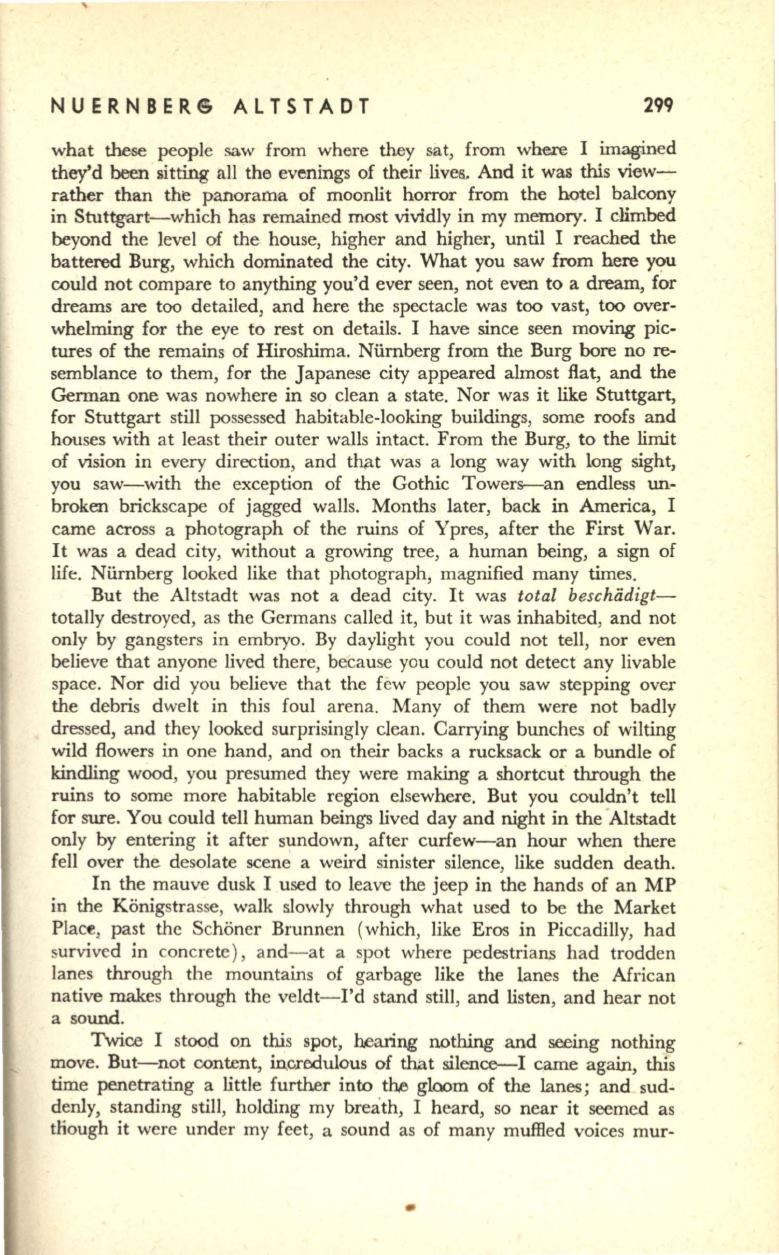
NUERNBERS
ALTSTADT
299
what these people saw from where they sat, from where I imagined
they'd
been
sitting all the evenings of their live&, And it was this view–
rather than the panorama of moonlit horror from the hotel balcony
in Stuttgart-which has remained most vividly in my memory. I climbed
beyond the level of the house, higher and higher, until I reached the
battered Burg, which dominated the city. What you saw from here you
could not compare to anything you'd ever seen, not even to a dream, for
dreams are too detailed, and here the spectacle was too vast, too over–
whelming for the eye to rest on details. I have since seen moving pic–
tures of the remains of Hiroshima. Niirnberg from the Burg bore no
re–
semblance to them, for the Japanese city appeared almost flat, and the
German one was nowhere in so clean a state. Nor was it like Stuttgart,
for Stuttgart still possessed habitable-looking buildings, some roofs and
houses with at least their outer walls intact. From the Burg, to the limit
of vision in every direction, and that was a long way with long sight,
you saw-with the exception of the Gothic Towers--an endless
un–
broken brickscape of jagged walls. Months later, back
in
America, I
came across a photograph of the ruins of Ypres, after the First War.
It was a dead city, without a growing tree, a human being, a sign of
life. Niirnberg looked like that photograph, magnified many times.
But the Altstadt was not a dead city. It was
total beschadigt–
totally destroyed, as the Germans called it, but it was inhabited, and not
only by gangsters in embryo. By daylight you could not tell, nor even
believe that anyone lived there, because you could not detect any livable
space. Nor did you believe that the few people you saw stepping ove,r
the debris dwelt in this foul arena. Many of them were not badly
dressed, and they looked surprisingly clean. Carrying bunches of wilting
wild flowers in one hand, and on their backs a rucksack or a bundle of
kindling wood, you presumed they were making a shortcut through the
ruins to some more habitable region elsewhere. But you couldn't tell
for sure. You could tell human beings lived day and night in the Altstadt
only by entering it after sundown, after curfew-an hour when there
fell over the desolate scene a weird sinister silence, like sudden death.
In the mauve dusk I used to leave the jeep in the hands of an MP
in the Konigstrasse, walk slowly through what used to be the Market
Plac~,
past the Schoncr Brunnen (which, like Eros in Piccadilly, had
survived in concrete ), and-at
a
spot where pedestrians had trodden
lanes through the mountains of garbage like the lanes the African
native makes through the veldt-I'd stand still, and listen, and hear not
a
sound.
1\vice I stood on
this
spot,
hearing
nothing and seeing nothing
move. But-not content, incredulous of
~t
silence-! c.arne again, this
time penetrating a little further into the gloom of the lanes; and sud–
denly, standing still, holding my breath, I heard, so near it seemed as
tfiough it were under my feet, a sound as of many muffled voices mur-


